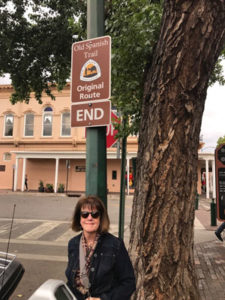
Author standing at the end of the Santa Fe Trail. In the background is the Santa Fe Plaza, the center of town, the end of the trail, and the oldest capital city in the U.S. Great history here.
During the 18th and 19th Centuries, people in America traveled. Some intentionally were on the move, intruding Europeans forced Native Americans off their lands, and slaves had no choice. For the most part, travel was by water, horseback, wagons, or foot. Two ways to travel were along a trace or a trail.
A trace can be described as a forest trail. The best known is the Natchez Trace, from New Orleans to Nashville. Farmers and boatmen floated goods and supplies down the Ohio and Mississippi rivers to sell. After trades were made, they broke up their log rafts and sold the timber, too.
The trace took about thirty-five days on foot and between twenty to twenty-five days on horseback. The trace was simply a path created by Choctaw and Chickasaw Indians before the arrival of white men. The trace crossed swamps, rivers and rolling hills. Robbers and highwaymen lurked in the dark forest. Two famous men to travel the Natchez Trace were Abraham Lincoln and Meriwether Lewis; the former became a U. S. President and the former was murdered along the Trace after leading the Lewis and Clark Expedition to the Pacific Northwest.
Trammel’s Trace is less famous but just as interesting. Known as the first road from the North into Texas, it began in Fulton, Arkansas, at the bend of the Red River and made its way to Nacogdoches and on to El Camino Real. This trace was 180 miles long and used by filibusters to smuggle mustangs from Spanish Texas to the U. S. in the 1820s. Highwaymen, gamblers and thieves found it lucrative. Gary Pinkerton wrote Trammel’s Trace: The First Road to Texas from the North. I highly recommend it.
Trails are much better known thanks to Hollywood and TV westerns. Cattle moved north to markets along the Chisholm and Western Trails after the Civil War. Families moved west along the Mormon Trail, the Oregon Trail and the Santa Fe Trail.
Traders and military couriers also used the Santa Fe Trail form 1821 to 1880. This trail covered some 1200 miles over semi-arid desert. The trek from Independence, Missouri, to Santa Fe, New Mexico, took from 40 to 60 days. Heat, lack of water, Plains Indians, and the chance of getting lost were dangers of the Santa Fe Trail.
A trail was much wider than a trace. Livestock and wagons travelled with comparative ease. No danger of highwaymen or robbers. Heat, lack of water, Plains Indians, and the chance of getting lost were the dangers of the trails.
Travelers along trails and traces had no GPS, no road maps, and really no signs like we have today. Guides were available on trails, but the trace was much easier to follow.
I had the opportunity to walk part of the Natchez Trace once. The roadbed was slightly lower that the terrain to each side. The shaded path and numerous trees reminded me I was in the woods and something could jump out at any moment. I’ve driven along different trails. They tend to exude feelings of thirst, fear of getting lost, and a sense of loneliness. But without them, how would our country have grown and developed?
